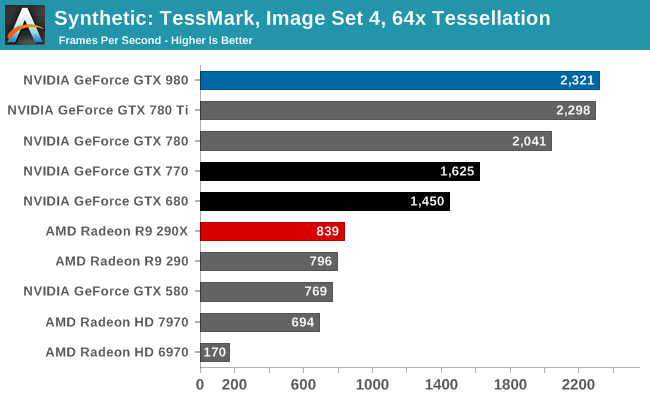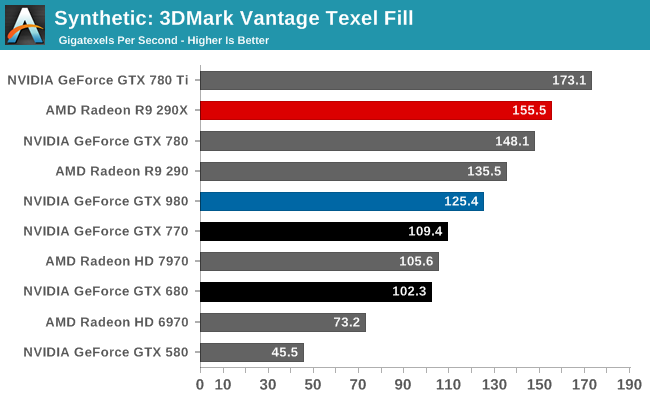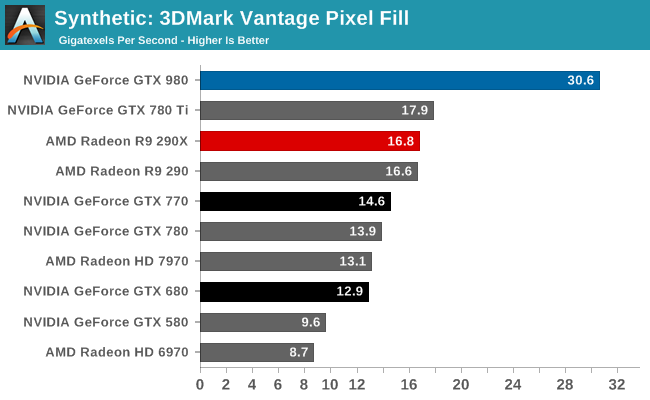The NVIDIA GeForce GTX 980 Review: Maxwell Mark 2
by Ryan Smith on September 18, 2014 10:30 PM ESTSynthetics
As always we’ll also take a quick look at synthetic performance. These tests mainly serve as a canary for finding important architectural changes, and with the exception of pixel throughput we are not expecting any major changes for GTX 980 and GM204.

GM204 is designed to have an ever-so-slightly higher triangle throughput rate than GK110 – 16 tris/clock versus 15 tris/clock, and sure enough the GTX 980 comes out on top in TessMark, slightly edging out the GTX 780 Ti. The difference is only very slight here, and though GM204 should be a bit more powerful than GK110 in practice it’s a dead heat.
Moving on, we have our 3DMark Vantage texture and pixel fillrate tests, which present our cards with massive amounts of texturing and color blending work. These aren’t results we suggest comparing across different vendors, but they’re good for tracking improvements and changes within a single product family.

Beginning with Maxwell NVIDIA reduced their texture-to-compute ratio from 12:1 to 16:1. As a result of this change Maxwell GPUs have fewer texture units than comparable Kepler GPUs. Compounding this effect is the fact that Maxwell CUDA cores are more efficient than Kepler CUDA cores, leading to NVIDIA placing fewer cores overall and further reducing the texture fill rate.
As a result the GTX 980 is not texture fillrate competitive with any of the GK110 cards. It is competitive with the GK104 cards, but only because these cards had the same number of texture units at 128. NVIDIA has told us that they believe this new ratio is a better fit for modern workloads, and judging from the performance we’re seeing elsewhere it would appear that NVIDIA is right.

On the other hand, thanks to NVIDIA’s newer 3rd generation delta color compression technology, our 3DMark pixel fillrate performance is through the roof. GTX 980 comes very close to doubling the throughput of our GK110 cards and more than doubles the throughput of the GK104 cards, reflecting the fact that it has 64 ROPs and more importantly has the available bandwidth to put them to good use.
This benchmark in a nutshell is why NVIDIA can deliver chart-topping performance despite having only 2/3rds the memory bandwidth of GTX 780 Ti. By improving their color compression to this point, NVIDIA can significantly reduce their memory bandwidth requirements Maxwell 2, allowing them to do more with less. In real games the result won’t be anywhere near this remarkable since this is a pure pixel fillrate test, but it goes to show that NVIDIA has been able to expand their effective memory bandwidth in concert with their ROP and shader performance improvements.










274 Comments
View All Comments
rennya - Friday, September 19, 2014 - link
Any info what HDMI 2.0 level and HDCP version this nVidia GPU has? It can only be between these ywo; HDMI 2.0 level B HDCP 2.2 or HDMI 2.0 level A HDCP 2.0.If it was the former, gaming performance in 4K displays that use HDMI 2.0. If it was the latter, this card is DOA when Bluray 4K videos comes out.
khanov - Friday, September 19, 2014 - link
Ideally, we consumers want a full HDMI 2.0 spec transceiver with 20+Gbps bandwidth AND HDCP 2.2. But these are not yet available and that is why we see these stop-gap measures that manufacturers are calling HDMI 2.0 A and B. This should *hopefully* be resolved by next year.In the meantime, I'd also like to know what exactly Nvidia is offering in the 970 and 980 cards. Without HDCP 2.2 the compatibility of these cards with future TV and AV gear is questionable.
Ryan, are you able to clarify please?
Ryan Smith - Saturday, September 20, 2014 - link
I don't have any more information available. But I will look into it.AnnonymousCoward - Friday, September 26, 2014 - link
If the stupid TV industry had went with the existing and mature DisplayPort interface for 4K, we wouldn't have these stupid HDMI 2.0 problems.warisz00r - Thursday, September 18, 2014 - link
So is it viable to drop a 970 or 980 in a sub-600W setup?dishayu - Thursday, September 18, 2014 - link
The whole system peaks at 300W. Even a cheap, non 80+ certified 500W power supply should be able to deliver that much with complete safety.Alexvrb - Saturday, September 20, 2014 - link
I would NEVER buy a PSU that isn't at least a somewhat halfway decent 80+ certified unit. Especially if you're going to then combine it with expensive components. At this point anything that falls under the category of "Cheap non 80+" is as likely to explode and catch fire as it is to run with complete safety. :P$30 gets you a 500W 80+ certified unit anyway.
nandnandnand - Thursday, September 18, 2014 - link
"GM204 ends up weighing in at 5.2 billion transistors, with a die size of 398mm2. This compares to 3.54B transistors and a die size of 294mm2 for GK104, and 7.1B transistors for 551mm2 for GK110."Does this mean there will be a 10 billion transistor GM210
extide - Friday, September 19, 2014 - link
Probably, yes, but not @ 28nm ;)Laststop311 - Friday, September 19, 2014 - link
I think you are right. Unless there is another huge delay big maxwell will not see the light of day till 20nm. At 28nm the die size would be astronomical and thats too expensive.